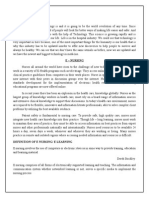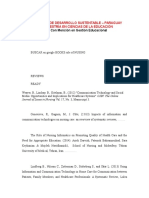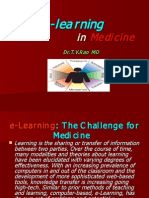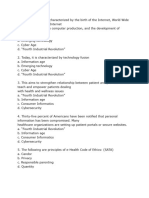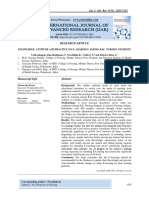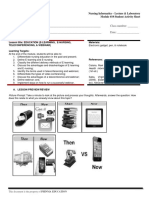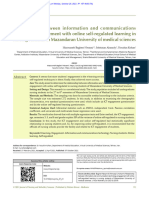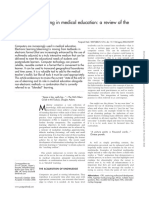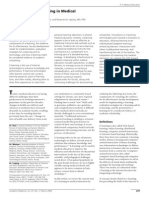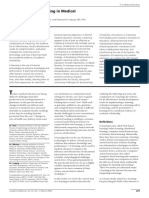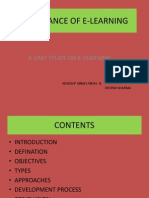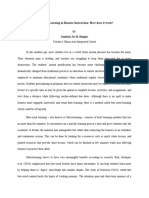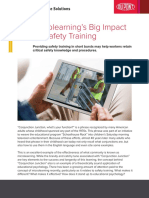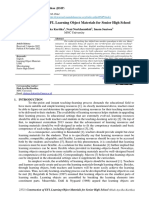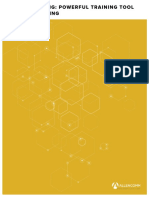Microlearning A Concept Analysis.3
Uploaded by
hatuvan2023Microlearning A Concept Analysis.3
Uploaded by
hatuvan2023FEATURE ARTICLE
Microlearning
A Concept Analysis
Jessica Cronin, DNP, MS, BS, RN, NI-BC, Marianne L. Durham, DNP, RN, CPPS, CPHQ
With an overall rise in technology adoption, the information- single-focused, and on-demand information-seeking behav-
seeking behaviors of today have become instant and single- iors have been fueled by the rise of social media allowing
focused, and demand convenience for learning and the ac- learning to take place anywhere and at any time the need
quisition of knowledge. Digital technologies expand the reach xuất hiện
arises.1,2 These new behaviors have given rise to the emergence
of learning and allow for the development of innovative and of microlearning. Microlearning is a short form of learning,
creative methods of teaching. The use of microlearning has thay vì
where targeted content is delivered over minutes as opposed
been gaining popularity in academic and professional develop- 3
to hours or days. Identified as a new dynamic, socially oriented
ment settings and corporate training. Currently, there is no
standardized definition of microlearning. Using Walker and way to learn, microlearning has been gaining adoption in
Avant's method of concept analysis, a comprehensive over- many industries, including healthcare. Microlearning as-
view of microlearning is provided through identifying the con- sumes learners are ready to engage in the process of learning
thuộc tính trường hợp mâu thuẫn
cept and describing its uses, attributes, exemplary cases, and in the quest for knowledge and understanding. Differen-
tiền đề
antecedents, consequences, and empirical referents. Seven tiating microlearning from traditional learning where both
attributes associated with microlearning are single focus,
kích thước nhỏ không đồng bộ
instructor and student are present at a specific hour and place,
linh hoạt
bite-sized, asynchronistic, accessibility, flexibility, interactiv- microlearning leverages electronic learning (e-learning) taking
ity, and multimodal delivery. A proposed definition is a place using the Internet or online, via electronic devices such
self-directed, on-demand, teaching strategy where small as a computer or smartphone.4 Currently, there is no com-
single-focused interactive content is presented to learners
cung cấp mon or standard definition of microlearning. This concept
asynchronously, using technologies that accommodate multi-
analysis will evaluate and provide a definition through its
modal delivery, and access where and when convenient for
the learner. This analysis will assist informatics and nursing characteristics or attributes that collectively facilitate learning.
educators in understanding how microlearning, as a strategy, Microlearning defined provides a referent for the potential
fits into the electronic learning landscape, is supported by use in nursing informatics and interprofessional healthcare.
tin học điều dưỡng liên ngành
digital technologies, and adds portability to leverage in an
on-demand asynchronous way providing targeted learning BACKGROUND
for use in all areas of clinical practice. Technology
KEY WORDS: Bite-sized learning, Just-in-time learning, Technology has substantially changed in the last decade resulting
Microcontent, Microeducation, Microlearning in Americans adopting and owning a range of stationary and
mobile electronic devices. Over 75% of the US population
own a desktop or laptop computer, and roughly 34% own
earning through the daily use of technology has become a tablet device.5 Whereas computer usage worldwide has
L fundamental to the way we work and live. Digital tech-
nologies afford portability to information enrichment,
supporting software that can be accessed and used on an in-
seen increased adoption, smartphone growth has occurred
at a staggering rate. Smartphone mobile network subscriptions
reached 6.4 billion in 2022, with the highest number of sub-
creasing number of mobile platforms. These technologies scriptions seen in China, India, and the United States.6 In
expand the reach of learning and allow for the development 2011, 35% of the US population owned a cellphone. Today,
of innovative and creative methods of teaching. Instant, cellphone ownership is 97%, with smartphone ownership at
85%. The reliance on smartphones for online access to infor-
Author Affiliation: College of Nursing, University of Illinois Chicago. mation is significantly higher among younger adults and
The authors have disclosed that they have no significant relationships with, or financial interest
in, any commercial companies pertaining to this article.
progressively lessens with age.5 Wi-Fi, Bluetooth, and Inter-
Corresponding author: Jessica Cronin, DNP, MS, BS, RN, NI-BC, 210 Berry Pkwy, Park Ridge, IL net access are central to both personal and professional ac-
60068 (jcronin123@comcast.net). tivities. Electronic learning can be defined as online learning,
Supplemental digital content is available for this article. Direct URL citations appear in the using the Internet and electronic devices such as a computer or
printed text and are provided in the HTML and PDF versions of this article on the journal’s
Web site (www.cinjournal.com). smartphone.4 Delivering educational content using e-learning
Copyright © 2024 Wolters Kluwer Health, Inc. All rights reserved. has enhanced traditional learning approaches, minimized
DOI: 10.1097/CIN.0000000000001122 geographical barriers, and increased the immediacy of
tính tức thời
Volume 42 | Number 6 CIN: Computers, Informatics, Nursing 413
Copyright © 2024 Wolters Kluwer Health, Inc. All rights reserved.
FEATURE ARTICLE
communication and the demand for technology-enhanced concepts, presented research literature hierarchy of evidence
learning.5,6 to nurse writers.
Technology-Enhanced Learning Review of the Literature and Data Sources
Technology-enhanced learning uses the field of digital tech- To understand the concept of microlearning in healthcare, a
nologies as mediums to deliver educational activities that are literature review using the PubMed, CINAHL, EMBASE,
blended with more traditional educational approaches.7 The ERIC, and PsycINFO databases and the search engine Google
instruments of digital technology, including videos, podcasts, Scholar was performed. Keyword searching used variations on
and online games, put learning in the hands of the learner, the terms microlearning, microlecture, microcontent, microeducation,
add portability to learning, and promote self-directed learning, microformat, microteaching, microfeedback, minicourse, just-in-time learning,
interactive learning, and collaboration in the learning process bite-size, and healthcare in combination with the Medical Subject
hạn chế về mặt không gian
without spatial restraints.1,8 Although still seen as complemen- Headings terms nurses, nurses by education level, and nurses by spe-
tary to traditional learning, there has been a significant rise in cialty. Boolean operators AND and OR, as well as title and
independent e-learning educational approaches that can meet abstract analysis in CINAHL, ERIC, and PsycINFO, were
the mobile and on-demand training needs of today.7 The global added in combination with search terms. The limiters of English,
COVID-19 pandemic further facilitated the push for teaching peer-reviewed, and years 2003-2023 were applied (see Supple-
and learning activities to move to online environments.9 Adult mental Digital Content Table 1, http://links.lww.com/CIN/
learners, with limited time for learning, desire training that meets A329). Records identified from database searching yielded
phổ biến trong
the demand for quick access, can be easily consumed, is ubiquitous 462 articles. Articles removed by title not relevant to topic
in nature, and is delivered via Web-based or mobile platforms.2,3
bản chất
and duplicates numbered 310, leaving 152 for abstract review.
Inclusion criteria for additional study review included (1)
Rise of Microlearning
microlearning used for education, training, or teaching; (2) ar-
Microlearning has been gaining popularity in corporate train-
ticles published after 2012; and (3) healthcare-oriented study
ing, academics, and professional development settings due to
population. Exclusion criteria included (1) microlearning not
its asynchronistic nature and in the presentation of small fo-
quan niệm used as an intervention for the purposes of healthcare educa-
cused single objective lessons, facilitating the notion that “less
tion, training, or teaching; (2) microlearning used for patient
is more.”2,3 Timely and focused presentation of information
education; and (3) trade and industry articles. After applying
in the form of demonstration, gamification, question and an-
criteria to the abstract review, 32 articles were further reviewed,
swer, videos, quizzes, and short exercises can be used alone or
removing an additional 11 nonrelevant articles and leaving 21
in combination.2,3,10 Reasoning for microlearning includes re-
giảm tải articles for full-text review. Full-text analysis resulted in 11 arti-
ducing complex memorization, lessening the cognitive load
mệt mỏi về mặt tinh thần cles deemed to have relevance. The same search strategy, using
and mental fatigue for the learner, and providing just-in-time
keywords only, was subsequently applied to Google Scholar,
learning for immediate application to practice. In clinical prac-
yielding 1 article for inclusion. In total, 12 scholarly articles
tice settings, microlearning is used to deliver clinical guidelines
were selected for analysis (see Supplemental Digital Content
education, skill development, refresher trainings, and diagnosis
Table 2, http://links.lww.com/CIN/A330). To examine the
and symptom management, and to further promote clinical
concept of microlearning beyond primary research literature,
confidence, critical thinking, and problem-solving skills.3
two scoping and two systematic reviews were additionally in-
cluded. Organizational Web sites and online dictionaries were
METHODS manually searched, examining the concept of microlearning
Concept Analysis Method beyond published literature.
Walker and Avant11 posit an iterative process to concept The John Hopkins Quality Appraisal resource was used
analysis as a way of examining the basic elements of a con- to evaluate the 12 primary and 4 secondary individual article
cept for better understanding and to develop a common def- evidence level and quality. The resource represents five levels
inition that allows communication and measurement of that of evidence corresponding to the methodological strength of
concept. Their eight-step approach includes: (1) selecting a the study design. Level I represents the strongest or highest
concept; (2) determining the aim or purpose of analysis; (3) level of evidence, whereas level V is given to a study with less
identifying uses of the concept; (4) determining and defining rigor or the lowest level of evidence. Study quality is addition-
attributes; (5) outlining a model case; (6) identifying other related ally defined as high, good, or low.12 Across the 16 published
or contrary cases; (7) identifying antecedents and consequences; articles, an experimental pilot study by Herstein et al13 and
and (8) defining empirical referents.11 This concept analysis of an experimental clinical control study by You and Liu14 are
microlearning was part of a quality improvement project level I studies of good quality. Four studies are level II
where a developed educational course, using microlearning nonrandomized control and quasi-experimental studies with
414 CIN: Computers, Informatics, Nursing June 2024
Copyright © 2024 Wolters Kluwer Health, Inc. All rights reserved.
good quality.15–18 Six studies are level III mixed method and focus with each learner-content interaction.13–24 Eight studies re-
qualitative studies with good quality.19–24 Two scoping reviews ported delivery of microlearning across multiple electronic me-
are level III with good quality.2,3 Two systematic reviews are diums including mobile devices such as phones or tablets, and
level III with good quality.7,8 Web-based, desktop, or workstation platforms.14,15,17–21,23
Seven studies reported geographical disbursement of learners
RESULTS ingesting content, promoting the efficacy of microlearning
Concept Identification and Analysis to deliver education to healthcare workers in a location of
The online dictionaries of Merriam-Webster, Cambridge Dic- their choosing.14,16–19,22,23
Tiện ích
tionary, and Oxford English Dictionary are all void of a defini-
Microlearning Utility
tion for microlearning.25–27 WhatIs.com, an online technology
reference resource, offered the definition of microlearning as a Seven studies engaged microlearning to support a just-in-time
teaching strategy that breaks complex topics down into short learning approach, with nine studies offering educational
stand-alone units of study that can be viewed when and where, content delivery in under 15 minutes.13,16–24 Self-learning
or as many times the learner has the need.28 In an article writ- described as bite-sized, small, lessons that offered an independent
ten for the American Organization for Nursing Leadership, approach to learning was reported in eight studies.14,15,17–22 Six
microlearning is defined as brief education sessions that teach studies directly used microlearning as an opportunity for in-
one specific skill in less than 5 minutes, further describing teractive learner engagement offering quizzes, checklists,
microlearning sessions as simple, to the point, concrete prin- self-assessments, and feedback, and seven studies offer micro-
ciples occurring within an environment of the learner's choice.29 learning on demand allowing for flexibility in content retrieval
The American Nurses Association's Innovation Advisory where convenient for the learner.13,16,18–23
Committee defines microlearning as dealing with small-unit,
short-term learning activities.30 Mak et al,31 in a letter to the Determining and Defining Attributes
editor, defined microlearning as packaging educational con- Determining the attributes of a concept provides the broadest
tent into bite-sized portions, covering very specific material, insight into characteristics universally associated with the con-
and delivering short intervals to introduce new or support pre- struct of the concept.11 Repeatedly seen in the literature, these
viously learned material. attributes can provide consistent recognition of microlearning
The performed literature review revealed four articles offer- as a teaching strategy. Identified are seven attributes associated
ing a definition for microlearning.16,18,19,22 Hegerius et al19 de- with microlearning: single focus, bite-sized, asynchronistic,
fined microlearning as small learning units associated with spe- accessibility, flexibility, interactivity, and multimodal delivery
cific learning objectives. Orwoll et al16 defined microlearning as (see Supplemental Digital Content Table 3, http://links.
contextual technology-enhanced focused learning. Prior et al22 lww.com/CIN/A331).
offered microlearning as occurring online and without real-
time or interpersonal interaction for the purpose of delivering Single Focus
easily accessible, small units of focused information. Microlearning can stand alone as an individual learning task
Zarshenas et al18 defined microlearning as content and train- or be incorporated into larger traditional learning or e-learning
ing presented in smaller sections sequentially, applied using activities. Microlearning can cover any subject that traditional
mobile technologies, and that include brief written tutorials, learning covers, but instructional content is broken down to fo-
graphics, podcasts, and video clips. In the remaining identified cus on a specific skill or knowledge gap. Learning objectives are
articles, microlearning was not defined but offered as just-in- singular or few and narrow in nature, requiring complex topics
time learning, compressed format learning, virtual learning, to be broken down into simple parts. Content is developed in a
and microteaching.13–15,17,20,21 step-by-step approach where lessons are dissected and pre-
sented in few words or sentences.13,19
Uses of the Concept
Although there are numerous scenarios where microlearning Bite Size
can be used, some examples may include the introduction or Small chunks, small lessons, short, “bite-sized” or small units
reinforcement of a job task, skill, knowledge enrichment or of comprehensible information as opposed to broad subject
creating awareness, follow-ups, or reminders about a new overviews is a hallmark characteristic of the design. The
program or initiative. All of the reviewed studies used micro- small chunks of information can stand alone or be pulled to-
learning as a teaching strategy and an approach to prioritiz- gether and tied to the larger category of focus, forming a
ing and highlighting health professions educational content, deeper connection to the topic. Lessons are simple, in logical
delivered over electronic platforms, using various multimedia order, and easily implemented over a short duration with de-
and communication methods, typically addressing a single signed completion times ranging from 90 seconds to
Volume 42 | Number 6 CIN: Computers, Informatics, Nursing 415
Copyright © 2024 Wolters Kluwer Health, Inc. All rights reserved.
FEATURE ARTICLE
15 minutes.13,15,21,23 The most reported duration times Multimodal Delivery
are 5 to 10 minutes.13,18–20,22,29 Multiple software platforms and electronic mediums includ-
ing mobile devices such as phones or tablets, Web-based,
Asynchronistic desktop, or workstations have been used for content delivery.
Microlearning is independent or asynchronistic by design and Delivery, enabled to multiple technologies, releases the chains
facilitates self-directed or user-driven learning. Developed to tied to one device or setting, allowing learners the freedom to
meet the learner when and where they are ready to learn, it enjoy learning by removing spatial restraints typically associ-
is often described as just-in-time learning. The concept of just- ated with traditional or single technology learning.
in-time learning comes from manufacturing origins where
supplies are not stocked in anticipation of need but rather Example Cases: Model and Additional Cases
made available when needed.21,26 Transference of this con- To contribute to the clarity of the concept, Walker and Avant11
cept can be seen in the technology-driven culture of today emphasize the need for exemplar cases. Cases can be found in
where mobile device information-seeking behaviors have cre- literature or be theoretical in nature and are used to convey a
ated an environment where learners pull information from deeper understanding for incorporating the attributes of a con-
online sources when they need it. Learners seek information cept. A model case provides an outlined example of the concept
at home, at work, and when convenient for learning, whether containing all the defined attributes. Additional cases examined
seeking to perform a task or for knowledge enrichment. will demonstrate cases where most, some, or none of the attri-
butes are present. This concept analysis will offer illustrations
Accessibility for a model, borderline, and two contrary cases.
Microlearning is accessible on demand. Technology platforms
can provide round-the-clock access to learning, letting learners Model Case
control the location, pace, and timing for education delivery. In this example, Lucy, a nurse editor working for a national
Platforms of delivery can include hardware technologies such publishing company, is responsible for a team of nurse writers
as desktop or laptop, mobile phones or tablets, or other speci- who write evidence-based clinical topics for nurses at the point
fied clinical electronic devices.2,13,15,16,18,19,21 When using tech- of care. She identifies variability in the mastery of the level of
nology, mobile-friendly software gives learners greater acces- evidence hierarchy and the research study designs contained
sibility on any digital device. A learning management system at each level. Company leadership requests education to in-
is not required, and many applications used in the classroom crease writer awareness and knowledge, and improve
have associated mobile-friendly applications. self-efficacy for using levels of evidence in the critical appraisal
process. A quality improvement project headed by Lucy, with
Flexibility a small team of editors, is undertaken.
Location and time independence allows for learning where The first item considered by the team is that all writers for
or when convenient for the learner. Traditional learning that the organization work remotely and are in different US time
uses text-heavy courses is not ideal for learning in short stints. zones. Traditional in-classroom learning options, such as a
Adult learners prefer self-directed learning or learning when workshop or training program, were considered but deemed
they have the need-to-know; microlearning lets them engage inflexible, time intensive, and cost prohibitive. The solution
in the acquisition of knowledge when they are ready. Micro- needed to include electronic delivery of educational content
learning flexibility allows learners to view all content or, if that could be accessed anytime, from anywhere, and using
modular in nature, skip to specific content, viewing as many any type of computing device. The agreed-upon solution was
times as desired. Self-paced learning that allows repetitive in- to create a short e-learning module leveraging microlearning
teraction and viewing has been associated with increased as a teaching strategy. The learning module would contain
learner satisfaction and retention.19,21 five short 3-minute microlearning segments each briefly pre-
senting hallmark characteristics for studies at each level of
Interactivity the five-level hierarchy. A table of contents lets users view
Short bursts of content with interactivity keep the learner's all levels sequentially or skip to the desired learning level.
attention and increase learner engagement. Effective instruction Presentation of content would be in the form of short text de-
can be achieved through relevant interactive multimedia. Multi- scriptions, infographics, and flash cards followed by a brief
media can come in the form of videos, podcasts, photos, illustra- self-assessment activity providing repetition and immediate
tions, and dashboards.13–16,18,21 Gamification can engage learners user feedback for correctness, in the form of question and an-
in hands-on interactive learning experiences and can come in the swer, matching, and sorting activities. Developed content
form of flashcards, concept matching, question and answer, would be placed in a storyboard template using a step-by-
quizzes, checklists, games, and short exercises.16 step logical arrangement starting with the highest level in
416 CIN: Computers, Informatics, Nursing June 2024
Copyright © 2024 Wolters Kluwer Health, Inc. All rights reserved.
the hierarchy representing studies with the strongest method- to attend and asked to purchase a corresponding textbook
ological rigor. Not having access to a learning management prior to class. This is an example of traditional learning.
system, the team decides to use a Web authoring software ap- A second case involves EMR training as a requirement for all
plication, currently owned by the organization, that supports new resident physicians. A 4-hour video lecture, delivered elec-
accessing the learning module from a desktop, tablet, or mo- tronically, reviews and demonstrates various clinical scenarios
bile phone. The software also allows users to engage, leave, and how to electronically document. Additionally offered are tips
and return to the same application location where previously and tricks and how to personalize the user experience. Resident
left at any time. A Weblink to the course could be emailed to physicians may view the course from any location on a desktop
nurse writers facilitating on-demand access. The entire course computer. The course is delivered via a learning management
was created and designed to be completed in under 15 minutes, system, only after hospital-required single sign-on is completed.
with each microlearning segment lasting 3 minutes or less. This case is not microlearning and more akin to traditional
This model case, set up in the form of e-learning with five learning presented as an online e-learning activity. Although
defined microlearning segments, includes all seven universal the course is asynchronistic allowing on-demand access, it is
attributes of microlearning. Lucy and the team are focused not single focused offering bite-sized learning and is absent
on creating small bursts of focused content representing stud- of interactivity.
ies at each level of the evidence hierarchy. The developed
course is asynchronistic allowing writers to access when convenient Antecedents and Consequences
through an emailed Weblink. The software application selected The next step in concept analysis is the identification of ante-
for content delivery supports multimodal platforms providing ac- cedents, which shed light on the utilization or social context
cessibility to learning from desktops, tablets, and smartphones. occurring prior to the concept.11 Three antecedents were
Learner engagement with the content is supported through identified for successful development of microlearning and
flashcards, question and answer, matching, and sorting activities. include andragogy, a systems approach to online learning
Learning is flexible and self-paced allowing learners to engage development, and the utilization of software applications.
and disengage with the learning activity when desired.
Andragogy giáo dục cho người lớn
Borderline Case Theoretical underpinnings related to models and theories
A borderline case contains most, but not all, defining attributes exploring adult learning, experiential learning, social con-
of the concept.11 In this example, an acute care hospital study structivism, or connectivism support the implementation of
team coordinated the development of a central line–associated microlearning.1,3,32–34 Microlearning recognizes learning
bloodstream infection learning module to educate nurses on as collaborative learning, offering educational experiences
best practices for central line care. Purchased gamification that take place in different situations and, through the appli-
software supported microlearning segments (approximately cation of andragogy, can fit the purpose of the learning
2 minutes) of self-assessment question and answer, checklists, event. An example of such a model is the Andragogy in Prac-
brief text explanations, and pop-up, on-demand short videos, tice Model focusing on adults as self-directed learners.29,34
to engage nurses in learning about central line–associated Recognizing the lack of homogeneity among learners and
bloodstream infection prevention interventions and activities. learning situations, six core adult learning principles are of-
Nurses were provided unrestricted access via the hospital's fered: (1) adults need to understand the what and why they
single sign-on system and encouraged to complete during clin- need to know something; (2) adults want autonomy over what
ical shift working hours. Nurses had access to interact with the to learn and experience self-directedness; (3) adults will use
application and videos on demand as many times as desired.16 prior experience as a source of learning; (4) adults need to be
In this case, the education was singularly focused on central ready to learn; (5) adults have a problem-centered approach
line–associated bloodstream infection prevention. Learning to learning, which is based on real-life orientation; and (6)
was asynchronistic, delivering small brief learnings and allowing adults are motivated by internal or intrinsic factors rather than
nurses to access interactive content on demand when conve- by external factors.32
nient during their work shifts. This learning did not accom-
modate for multimodal device delivery. Systems Approach
A systems approach organizes and arranges content based on
Contrary Cases the premise that all the elements of learning are interconnected
A contrary case is a clear example of what is not the concept.11 and together form a holistic view of the concept. Supported is
In this first case, Sally, a nurse educator for an acute care hos- the sequential nature of microlearning where elements or parts
pital, delivers through instruction, slide presentations, and videos are merged to form a whole focused concept. Direction should
a 4-hour basic life support course. Nurses are required to register follow logical interconnections understanding the iterative
Volume 42 | Number 6 CIN: Computers, Informatics, Nursing 417
Copyright © 2024 Wolters Kluwer Health, Inc. All rights reserved.
FEATURE ARTICLE
nature of microlearning. Objectives, the goals of learning de- Knowledge Retention
fined, and appropriate delivery methods ground the instruc- Few studies focused on knowledge retention after microlearning
tional content and technological components (media, software, intervention. In studies where retained learned skills and associ-
and hardware) selected. How well the parts operate and inter- ated desired behavior changes were explored, self-assessment
act together determines the success of learning. Several models surveys reported microlearning to be “just right” for adequate
and methodologies for developing educational materials exist learning and retention.13,21 Pade et al21 additionally reported
and include ADDIE (Analysis, Design, Development, Imple- minimal knowledge decay of 18%, representing a drop in
mentation, Evaluation), SAM (Successive Approximation knowledge retention from 91% to 73% at 5 months post
Model), SMART (Specific, Measurable, Attainable, Relevant, microlearning intervention.
Time-bound), and ADL (Agile Learning Design).32
Software Applications Empirical Referents
The empirical referents do not measure the concept itself but
Software applications, whether stand-alone or plug-in, should
rather identify categories that demonstrate the occurrence of
be easy to use and possess systematic properties that enable,
the concept.11 The defining characteristics can be used as the
even unprepared learners, simplistic engagement. Consider-
means to recognize its real-world contribution as an effective
ation is given to the software's use of templates and other stan-
e-learning teaching strategy removing the boundaries and
dard functionality offerings, as well as the ability to support in-
constraints of traditional learning. Whether used alone or
teractivity (recording of video lessons, games, simulations), the
in combination with other learning, the empirical referents
saving of user input, and interoperable output formats (.swf
for microlearning are the ability to deliver education to
format).32 Further evaluation should include requirements
learners that is self-directed, on demand, flexible and engag-
of software maintenance, ease of implementation, functional-
ing, and void of geographical constraints, with the intent to in-
ity for developer programming, the user interface, price, and
crease knowledge uptake and retention as well as self-efficacy,
market maturity.32 Software used for educational content de-
fostering the ability to apply learnings to practice. Although
velopment should support multiplatform delivery and facili-
empirical referents are not methods of measurement, each
tate technology device freedom and mobility, removing all
of the research studies evaluated reviewed microlearning re-
potential spatial restraints imposed on a learner.
cording both the learners' and educators' experiences, lending
In concept analysis, consequences are those events that di-
insights into measurement and analysis.
rectly result from the occurrence of a concept.11 The literature
review revealed outcomes related to learner knowledge uptake, Operational Definition
confidence and self-efficacy, attitudes, and longer-term
As the defining attributes and themes of microlearning were
knowledge retention.
explored, it was evident that microlearning needed to be de-
Knowledge Uptake, Confidence, and Self-efficacy fined to differentiate it from other forms of learning. To this
end, the following definition is proposed: Microlearning is a
Increased learner knowledge uptake or skill, confidence, ca-
self-directed, on-demand, teaching strategy where small
pacity to execute learnings, and the ability to immediately ap-
single-focused interactive content is presented to learners asyn-
ply learnings to practice were broadly identified.13–24 Micro-
chronously utilizing technologies that accommodate multi-
learning improves self-learning by stimulating an interest in
modal delivery, and access where and when convenient for
learning. Decreased are memorization, the learner's cognitive
the learner.
load, and the associated stress typically present in traditional
methods of teaching.14,20
Limitations
Attitude Towards Microlearning The purpose of this concept analysis was to collectively de-
Attitudes towards microlearning revealed general positivity fine the attributes of microlearning and provide a referent
towards educational content size, on-demand flexibility, for potential use in nursing informatics and interprofessional
the learning experience in general, and increased learner healthcare. Current literature is limited to a few studies mea-
satisfaction.14,17–20,22,23 Gamification was instrumental in suring microlearning in nursing and healthcare. The role
showing how a positive learning experience can influence and interaction of the informaticist with microlearning does
nurse behavior, increase engagement, and lead to better pa- not appear in the literature examined. Without a common
tient outcomes.16 Additional reported perceptions include standard definition, variations in implementation and analy-
microlearning as being well received, easy and enjoyable, sis will ensue. Future studies will need to focus on defining
and an effective way to learn, and that this type of learning use cases for microlearning and ways to comprehensively
would be recommended to others.19,20 measure efficacy in both nursing and healthcare settings.
418 CIN: Computers, Informatics, Nursing June 2024
Copyright © 2024 Wolters Kluwer Health, Inc. All rights reserved.
CONCLUSION updated, construction of knowledge happens in real time, and
Although there are various teaching methods leveraging learning becomes a “pull” instead of a “push” activity.
e-learning, microlearning has emerged as a useful teaching
strategy in many industries including healthcare. This con- References
cept analysis provides a comprehensive overview of micro- 1. Alismaiel OA, Cifuentes-Faura J, Al-Rahmi WM. Online learning, mobile
learning by providing a definition and describing its uses, at- learning, and social media technologies: an empirical study on
constructivism theory during the COVID-19 pandemic. Sustainability. 2022;
tributes, exemplary cases, antecedents, consequences, and 14(18): 11134. doi:10.3390/su141811134.
empirical referents. With an overall rise in digital technology 2. Taylor A, Hung W. The effects of microlearning: a scoping review. Educational
adoption, the information-seeking behaviors of today have Technology Research and Development. 2022;70(2): 363–395. doi:https://
doi.org/10.1007/s11423-022-10084-1.
become instant, single-focused, and convenient for learning
3. De Gagne JC, Woodward A, Park HK, Sun H, Yamane SS. Microlearning in
and the acquisition of knowledge. Microlearning brings an health professions education: a scoping review protocol. JBI Database of
instructional approach to teaching, outside the classroom, Systematic Reviews and Implementation Reports. 2019;17(6): 1018–1025.
doi:https://doi.org/10.11124/jbisrir-2017-003884.
with the ability to stand alone or be a part of a larger learning
4. But VM, Bulboacă AI, Bolunduţ D, Boarescu PM, Bulboacă AE. Medical
activity. This analysis will assist informatics and healthcare edu- education—from traditional learning methods to e-learning methods. Applied
cators in understanding how microlearning, as a strategy, fits Medical Informatics. 2020;42(1): 1–8. https://ami.info.umfcluj.ro/index.
into the e-learning landscape, is supported by multimodal tech- php/AMI/article/view/756. Accessed August 22, 2023.
nologies, and adds portability to leverage in an on-demand 5. Pew Research Center. Mobile fact sheet. Pew Research Center Web site.
https://www.pewresearch.org/internet/fact-sheet/mobile/. Published
asynchronous way. Microlearning provides targeted learning April 7, 2021.
for use in academic, clinical, and professional arenas. 6. Taylor P. Number of smartphone users worldwide 2014-2020. Statista Web
site. https://www.statista.com/statistics/330695/number-of-smartphone-
users-worldwide. Published March 30, 2023.
7. Kim JH, Park H. Effects of smartphone-based mobile learning in nursing
Implications for Nursing Practice education: a systematic review and meta-analysis. Asian Nursing Research.
Informatics competencies include the introduction of technol- 2019;13(1): 20–29. doi:https://doi.org/10.1016/j.anr.2019.01.005.
ogy and methods that can educate, teach, and promote health 8. Nicoll P, MacRury S, van Woerden HC, Smyth K. Evaluation of
technology-enhanced learning programs for health care professionals:
and safety for patients, families, clinicians, staff, or anyone need-
systematic review. Journal of Medical Internet Research. 2018;20(4): e131.
ing access to quality health information.35 Considering the core doi:https://doi.org/10.2196/jmir.9085.
competencies for nursing education, the American Association 9. Heo H, Bonk CJ, Doo MY. Enhancing learning engagement during COVID-19
of Colleges of Nursing,36 in Domain 8: Informatics and Health- pandemic: self-efficacy in time management, technology use, and online
learning environments. Journal of Computer Assisted Learning. 2021;37(6):
care Technologies, outlines the nursing informatics process to 1640–1652. doi:https://doi.org/10.1111/jcal.12603.
include leveraging technologies to form information used to 10. Tennyson CD, Smallheer BA, De Gagne JC. Microlearning strategies in nurse
drive clinical decision making, expand knowledge, and enhance practitioner education. Nurse Educator. 2022;47(1): 2–3. doi:https://doi.
org/10.1097/nne.0000000000001083.
the wisdom of practice. Encouraging the use of digital com-
11. Walker L, Avant K. Strategies for Theory Construction in Nursing. 6th ed.
munication methods to deliver education in care settings im- Boston, MA: Pearson; 2018:167–184.
proves the provision and quality of patient care.36 12. Dang D, Dearholt S, Bissett K, Ascenzi J, Whalen M. Johns Hopkins
Harnessing microlearning as a form of e-learning, the pre- Evidence-Based Practice for Nurses and Healthcare Professionals: Model and
Guidelines. 4th ed. Indianapolis, IN: Sigma Theta Tau International; 2021.
sentation of single-focused information easily facilitates the
13. Herstein JJ, Gibbs SG, Kupzyk KA, Beam EL. Using a critical safety behavior
construction of knowledge when convenient for the nurse. Re- scoring tool for just-in-time training for N95 respirator use. Workplace Health
moved is the need to go to the nurses' station, office, or an- & Safety. 2022;70(1): 31–36. doi:https://doi.org/10.1177/
other location to learn. Whether learning occurs informally 21650799211031169.
14. You Y, Liu R. Application of micro-teaching in the training of intravenous
or through continuing professional development, expanded indwelling needle infusion for clinical nursing students. Yangtze Medicine.
knowledge at the point of care promotes the health literacy 2019;03(03): 176–182. doi:https://doi.org/10.4236/ym.2019.33018.
of the nurse in the workplace, allowing for immediate applica- 15. Davis JS, Garcia GD, Wyckoff MM, et al. Use of mobile learning module
tion to healthcare decisions and actions. A universal definition improves skills in chest tube insertion. Journal of Surgical Research. 2012;
177(1): 21–26. doi:https://doi.org/10.1016/j.jss.2012.03.022.
of microlearning brings a standardized application and consis-
16. Orwoll B, Diane S, Henry D, et al. Gamification and microlearning for
tency to healthcare and nursing practice usage. Example use engagement with quality improvement (GAMEQI): a bundled digital
cases are vast but can include the performance of a task such intervention for the prevention of central line–associated bloodstream
infection. American Journal of Medical Quality. 2017;33(1): 21–29. doi:
as the steps for insertion of a urinary catheter, or the imple- https://doi.org/10.1177/1062860617706542.
mentation of a safety strategy to prevent medication errors, 17. Sharma SK, Mandal A, Mishra M. Effectiveness of m-learning on knowledge
or mandatory organizational continued professional develop- and attitude of nurses about the prevention and control of MDR TB: a
quasi-randomized study. Indian Journal of Tuberculosis. 2021;68(1): 3–8.
ment. Microlearning is a legitimate method of learning in the doi:https://doi.org/10.1016/j.ijtb.2020.10.013.
workplace, one in which no educational preparation is needed, 18. Zarshenas L, Mehrabi M, Karamdar L, Keshavarzi MH, Keshtkaran Z. The
complex and ever-changing information can be individually effect of micro-learning on learning and self-efficacy of nursing students: an
Volume 42 | Number 6 CIN: Computers, Informatics, Nursing 419
Copyright © 2024 Wolters Kluwer Health, Inc. All rights reserved.
FEATURE ARTICLE
interventional study. BMC Medical Education. 2022;22(1): 664. doi:https:// 27. Microlearning. In: Oxford English Dictionary. Oxford University Press; 2023.
doi.org/10.1186/s12909-022-03726-8. https://www.oed.com/search/dictionary/?scope=Entries&q=microlearning.
19. Hegerius A, Caduff-Janosa P, Savage R, Ellenius J. E-Learning in 28. WhatIs.com. What is microlearning (microtraining)? WhatIs.com Web site.
pharmacovigilance: an evaluation of microlearning-based modules https://www.techtarget.com/whatis/definition/microlearning.
developed by Uppsala Monitoring Centre. Drug Safety. 2020;43(11): 29. AONL. Making it easy: team member microlearning with QR codes. https://
1171–1180. doi:https://doi.org/10.1007/s40264-020-00981-w. www.aonl.org/news/voice/making-it-easy.
20. Inker J, Jensen C, Barsness S, Stewart MM. Implementing microlearning in 30. Innovation Advisory Committee: Education and Communication Innovation
nursing homes: implications for policy and practice in person-centered Guide. Silver Spring, MD: American Nurses Association; 2023. https://www.
dementia care. Journal of Applied Gerontology. 2021;40(9): 1062–1070. nursingworld.org/~49456e/globalassets/innovation/guide/iac-education-
doi:https://doi.org/10.1177/0733464820929832. and-communication-resources_20230315.pdf.
21. Pade KH, Seik-Ismail ST, Chang TP, Wang VJ. Utilization of just-in-time training 31. Mak W, Franzosa E, Burack O, Reinhardt JP. Research needed on
for nursing education using the LA phonospirometry asthma tool. Journal of microlearning as a training strategy for CNAs in skilled nursing facilities.
Asthma. 2017;55(7): 811–815. doi:https://doi.org/10.1080/02770903. Journal of the American Medical Directors Association. 2021;22(12):
2017.1366507. 2610–2611. doi:https://doi.org/10.1016/j.jamda.2021.07.025.
22. Prior FH, Paton M, Tipping J, Schneeweiss S, Mack HG. Microlearning to 32. Nazarova OB, Pulekha IR, Maslennikova OY, Osipov YV. Rationale for
improve CPD learning objectives. The Clinical Teacher. 2020;17(6): choosing the model and tool for developing an e-learning course. Journal of
695–699. doi:https://doi.org/10.1111/tct.13208. Physics: Conference Series. 1661;2020: 012184. doi:https://doi.org/10.
23. Safavi AH, Papadakos J, Papadakos T, et al. Feedback delivery in an 1088/1742-6596/1661/1/012184.
academic cancer centre: reflections from an R2C2-based microlearning 33. Picciano AG. Theories and frameworks for online education: seeking an
course. Journal of Cancer Education. 2021;111(1): e21–e22. doi:https:// integrated model. Online Learning. 2017;21(3): 166–190. doi:https://doi.
doi.org/10.1016/j.ijrobp.2021.05.177. org/10.24059/olj.v21i3.1225.
24. Stoler GB, Johnston JR, Stevenson JA, Suyama J. Preparing emergency 34. Knowles M, Holton E, Swanson R, Robinson P. The Adult Learner: The
personnel in dialysis: a just-in-time training program for additional Definitive Classic in Adult Education and Human Resource Development. 9th
staffing during disasters. Disaster Medicine and Public Health Preparedness. ed. London, England: Routledge; 2020:79–88.
2013;7(3): 272–277. doi:https://doi.org/10.1001/dmp.2011.34.
35. American Nurses Association. Nursing Informatics: Scope and Standards of
25. Microlearning. In: Cambridge Dictionary. Cambridge University Press & Practice. 3rd ed. Silver Spring, MD: American Nurses Association; 2022:66–67.
Assessment; 2023. https://dictionary.cambridge.org/us/spellcheck/
36. American Association of Colleges of Nursing. The Essentials: Core
english/?q=microlearning.
Competencies for Professional Nursing Education. Washington, DC: The
26. Microlearning. In: Merriam-Webster Dictionary. Merriam-Webster; 2023. American Association of Colleges of Nursing; 2021:46–48. https://www.
https://www.merriam-webster.com/dictionary/microlearning. aacnnursing.org/Portals/0/PDFs/Publications/Essentials-2021.pdf.
420 CIN: Computers, Informatics, Nursing June 2024
Copyright © 2024 Wolters Kluwer Health, Inc. All rights reserved.
You might also like
- Microsoft Word - WEEK 17-NCMA112-Technology in Health EducationNo ratings yetMicrosoft Word - WEEK 17-NCMA112-Technology in Health Education5 pages
- Learning Outcomes of Digital Learning Interventions in Higher EducationNo ratings yetLearning Outcomes of Digital Learning Interventions in Higher Education11 pages
- E Nursing, Telemedicine and TelenursingNo ratings yetE Nursing, Telemedicine and Telenursing44 pages
- E-Learning, Telemadicin, Tele Nursing Assignment100% (2)E-Learning, Telemadicin, Tele Nursing Assignment22 pages
- Rethinking The Effects of Performance Expectancy and Effort Expectancy On New Technology Adoption - Evidence From Moroccan Nursing StudentsNo ratings yetRethinking The Effects of Performance Expectancy and Effort Expectancy On New Technology Adoption - Evidence From Moroccan Nursing Students9 pages
- Universidad de Desarrollo Sustentable - Paraguay Maestría en Ciencias de La EducaciónNo ratings yetUniversidad de Desarrollo Sustentable - Paraguay Maestría en Ciencias de La Educación7 pages
- 2010 - Electronic Learning and Constructivism in Nursing EduNo ratings yet2010 - Electronic Learning and Constructivism in Nursing Edu6 pages
- Microlearning Strategies in Nurse Practitioner.2No ratings yetMicrolearning Strategies in Nurse Practitioner.22 pages
- 6 - Electronic Media: Computer Learning ResourcesNo ratings yet6 - Electronic Media: Computer Learning Resources6 pages
- Technology-In-Education - 20240604 024935 0000No ratings yetTechnology-In-Education - 20240604 024935 000023 pages
- Knowledge, Attitude and Practice On e - Learning Among B.sc. Nursing StudentsNo ratings yetKnowledge, Attitude and Practice On e - Learning Among B.sc. Nursing Students8 pages
- Teaching and Learning For The 21 Century: Mrs. Ambika RavindranNo ratings yetTeaching and Learning For The 21 Century: Mrs. Ambika Ravindran33 pages
- Name: - Section: - Schedule: - Class Number: - DateNo ratings yetName: - Section: - Schedule: - Class Number: - Date18 pages
- Technology Acceptance Model TAM and E LeNo ratings yetTechnology Acceptance Model TAM and E Le13 pages
- The Impact of E-Learning in Medical Education: Dr. Ruiz Is Assistant Professor of Clinical MedicineNo ratings yetThe Impact of E-Learning in Medical Education: Dr. Ruiz Is Assistant Professor of Clinical Medicine6 pages
- The Impact of E-Learning in Medical Education: Dr. Ruiz Is Assistant Professor of Clinical MedicineNo ratings yetThe Impact of E-Learning in Medical Education: Dr. Ruiz Is Assistant Professor of Clinical Medicine6 pages
- Learning Guide: Ngeles Niversity OundationNo ratings yetLearning Guide: Ngeles Niversity Oundation9 pages
- The Synergy of Digital Knowledge and Skills in Forming Digital Citizenship: A Comprehensive Assessment On Nursing StudentsNo ratings yetThe Synergy of Digital Knowledge and Skills in Forming Digital Citizenship: A Comprehensive Assessment On Nursing Students8 pages
- GuidingStar Just One Thing Microlearning A Practitioners GuideNo ratings yetGuidingStar Just One Thing Microlearning A Practitioners Guide42 pages
- Examining The Digital Skills of Nursing Students: The Power of Information For Problem-SolvingNo ratings yetExamining The Digital Skills of Nursing Students: The Power of Information For Problem-Solving10 pages
- Technology Usage For Teaching and Learning in Nursing Education: An Integrative ReviewNo ratings yetTechnology Usage For Teaching and Learning in Nursing Education: An Integrative Review9 pages
- Application of Nursing Informatics Research and EducationNo ratings yetApplication of Nursing Informatics Research and Education23 pages
- 1.hum Usage of Smartphones Technology in Learning Environment and Its Effect On Academic100% (1)1.hum Usage of Smartphones Technology in Learning Environment and Its Effect On Academic22 pages
- Self-Assessment On ICT Knowledge, Skills, and AttitudesNo ratings yetSelf-Assessment On ICT Knowledge, Skills, and Attitudes5 pages
- Technology in Nursing Education and Practice A Global PerspectiveNo ratings yetTechnology in Nursing Education and Practice A Global Perspective6 pages
- CommLab India Blended Learning The Rapid Elearning WayNo ratings yetCommLab India Blended Learning The Rapid Elearning Way42 pages
- 6-3-Pratima-Majal-and-Woo-Boon-Seong (Micro-Learning To Support)No ratings yet6-3-Pratima-Majal-and-Woo-Boon-Seong (Micro-Learning To Support)26 pages
- E-Learning and Business Development Edufever PrivateNo ratings yetE-Learning and Business Development Edufever Private96 pages
- The Rise of Micro Learning in Corporate TrainingNo ratings yetThe Rise of Micro Learning in Corporate Training3 pages
- Unit 1-Lesson2 Different Generations of Learners100% (1)Unit 1-Lesson2 Different Generations of Learners17 pages
- The Design of Microlearning Experiences: A Research Agenda: ArticleNo ratings yetThe Design of Microlearning Experiences: A Research Agenda: Article10 pages
- Micro-Learning and Stackable CredentialsNo ratings yetMicro-Learning and Stackable Credentials7 pages
- The Effectiveness of Microlearning Approach From TNo ratings yetThe Effectiveness of Microlearning Approach From T11 pages
- Evaluating Microlearning Strategies in The Corporate EnvironmentNo ratings yetEvaluating Microlearning Strategies in The Corporate Environment224 pages
- Microlearning As An Alternative Teaching Model Influence of COVID19 in Latin America and The CaribbeanJournal of Higher Education Theory and PracticeNo ratings yetMicrolearning As An Alternative Teaching Model Influence of COVID19 in Latin America and The CaribbeanJournal of Higher Education Theory and Practice12 pages
- Micro-Learning and Stackable Credentials Presentation by Kaley WhiteNo ratings yetMicro-Learning and Stackable Credentials Presentation by Kaley White9 pages
- Microlearning and Its Effectiveness in Modern Education: A Mini ReviewNo ratings yetMicrolearning and Its Effectiveness in Modern Education: A Mini Review10 pages
- Maximize Learning Transfer Liz Herrick Microlearning CONFNo ratings yetMaximize Learning Transfer Liz Herrick Microlearning CONF32 pages
- Allencomm Microlearning Powerful Training Tool For Onboarding100% (1)Allencomm Microlearning Powerful Training Tool For Onboarding14 pages
- Microlearning: Knowledge Management Applications and Competency-Based Training in The WorkplaceNo ratings yetMicrolearning: Knowledge Management Applications and Competency-Based Training in The Workplace10 pages







